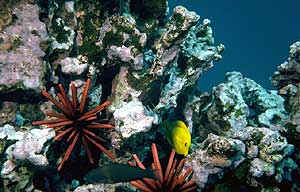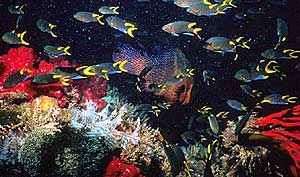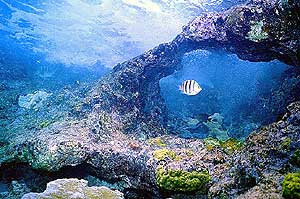
Situation
|
 A tropical fish takes shelter in a coral reef. ... |
 Photos: Australia's Great Barrier Reef provides a home for many species of fish. All Photos © 2003 www.clipart.com |
Scenario
Coral are tiny animals that live in the ocean. They are related to hydras, jellyfish, and sea anemones. A coral reef is a large rock-like calcium carbonate skeleton secreted by colonies of coral.
Coral reefs are very important to the ocean ecosystem. Many plants and animals rely on coral reefs for shelter. They also find their food there. Algae, sponges, clams, and many species of fish are among the organisms that live on coral reefs.
Coral reefs are home to so many types of organisms that they are often called the "tropical rainforest of the ocean.” A loss in coral reef habitat can lead to a dramatic loss of biodiversity. Many scientists are concerned that such a loss of biodiversity is already happening.
According to the U.S. Environmental Protection Agency’s Coral Reef Initiatives, an estimated 10 percent of Earth's coral reefs have already been seriously harmed, and a much higher percentage is threatened.
Challenge 1
The Committee on Reef Area Loss (CORAL) is concerned about the loss of biodiversity that could accompany a greatly reduced coral reef area. It has been looking into ways to prevent such a loss of biodiversity. CORAL is considering building artificial reefs where natural reefs are being destroyed. They have asked you to consider the pros and cons of artificial reefs and evaluate how well they would preserve biodiversity.
Challenge 2
Officials of the United Nations Environmental Program with headquarters in Nairobi, Kenya, have recently become concerned with news from scientists throughout the world that coral reefs are dying at alarming rates. The officials have called together representatives from nations around the world to examine the problem and make recommendations on what is to be done (if anything). As a member of the U.S. delegation, you have been assigned the job of thoroughly investigating the problem and making recommendations. You should consider a number of things:
- Are the reports true?
- If they are, what are the reasons?
- Are humans responsible for the death of coral reefs, or is it mostly a natural event?
Glossary ..|.. Related Links ..|.. References |..PBL Model
Home ..|.. Teacher Pages ..|.. Modules & Activities
Maintained by ETE Team
Last updated
March 08, 2004
Privacy Statement and Copyright © 1997-2004 by Wheeling Jesuit University/NASA-supported Classroom of the Future. All rights reserved.
Exploring the Environment®, Coral Reefs was developed under a cooperative agreement with NASA.
Some images © 2004 www.clipart.com
Center for Educational Technologies, Circuit Board/Apple graphic logo, and COTF Classroom of the Future logo are registered trademarks of Wheeling Jesuit University.
